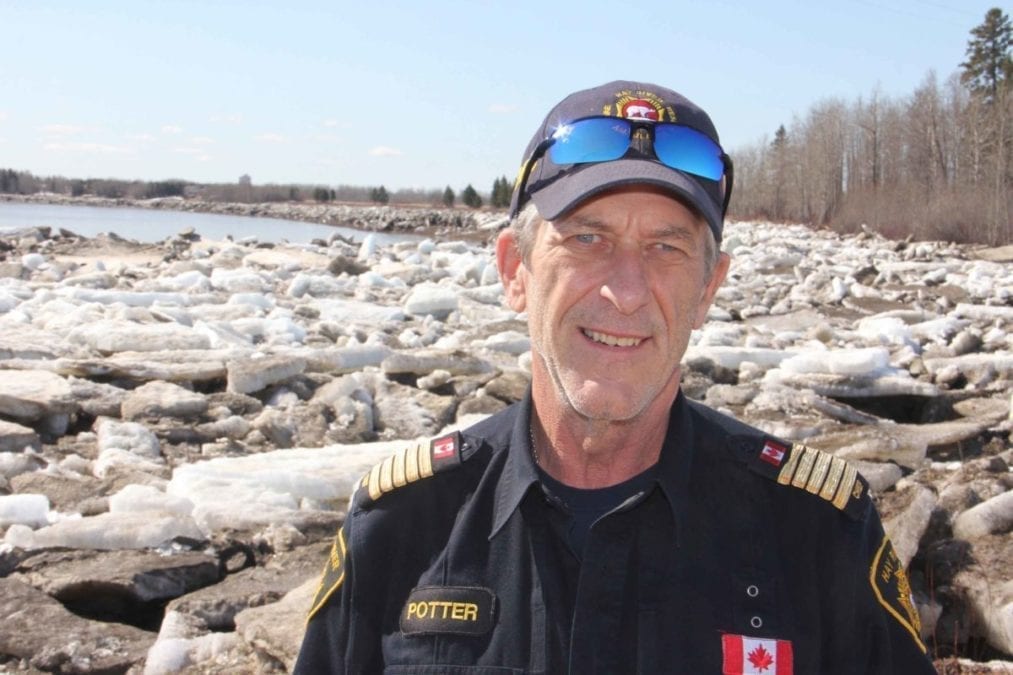
Paul Bickford/NNSL photo
There are no second thoughts by the Hay River official who recommended the evacuation of Vale Island because of potential flooding, which didn't actually happen.
"It was a good decision," said Ross Potter, director of protective services with the Town of Hay River. "I really don't like to evacuate people, but I'll totally stand by my decision on that. With everything the way it was shaping up, I really felt that we were going to get wet."
Town council voted for the evacuation on the evening of May 4.
"I made the recommendation that we pull the pin," said Potter, who is also the community's fire chief.
One of the major factors in that recommendation was the amount of water coming over Alexandra Falls, south of Enterprise.
"That, plus the amount of flow that was coming from down south," said Potter, adding that the high water upstream and the water heading towards town made the evacuation recommendation a fairly easy decision to make.
When the evacuation order was issued, over 1,200 cubic metres of water a second were going over Alexandra Falls, and there was ice in the Hay River area from the Pine Point Bridge to Great Slave Lake.
As for what happened to prevent significant flooding on Vale Island, Potter points to the Hay River's West Channel, noting the ice and water behaved just as the town would have asked it to behave.
"I would suggest that Mother Nature was on our side, finally," he said.
Potter explained there was a small release of water and ice on the evening of May 4, and then a large release the following day that went onto the lake – most of it to the west, some straight out into the lake, and some towards the east.
If the ice and water hadn't behaved that way, he believes there would have been significant flooding.
Potter said that, if he is faced with the same set of circumstances next year, he would again recommend an evacuation.
As it turned out, there was only minor flooding – but no property damage – in a couple of yards and some ditches in West Channel near the Oxbow Creek.
"We were able to curb the flow of the water from the Oxbow with some gravel and that type of thing," said Potter. "We dammed it up, so it stopped the flooding from that perspective."
As for the evacuation itself, he thinks it went really well, noting members of the fire department went door-to-door to advise people of the evacuation order.
"They got a fairly good response from the people that they talked to," he said. "I believe we had something like 32 homes that said they weren't leaving. But that's to be expected."
The evacuation order was lifted on the morning of May 6.
As of May 7 at 1 p.m., Potter declared the spring breakup complete, which happens when both the West Channel and East Channel are running free to Great Slave Lake.
Glenn Smith, the assistant senior administrative officer with the town, agrees with Potter's decision to call for an evacuation.
"It was the right decision," said Smith. "We know and history knows and dictates what can happen out there. And given the signs, it was a very risky time."
First and foremost, the town protects residents, he said. "In some respects, we feel that we got lucky with how the water drained out and moved through the West Channel. It could have been a lot worse with maybe a little less luck."
There are an estimated 190 households and over 450 people living on Vale Island, which includes West Channel and Old Town.
Unofficially, 362 individuals from about 153 households evacuated.
Smith was pleased with that high level of compliance.
The evacuees were accommodated in various places, including in 76 hotel rooms in Hay River.
Nine households totalling 24 people stayed in an RV park set up at the Hay River Community Centre, while others stayed in private accommodations.
"There seemed to be a fair number of people that parked their RVs elsewhere within town or had cabins," said Smith.
Six households with a total of 15 people drove to hotels in Yellowknife.
Smith said the registration centre at the Hay River Community Centre was very busy on the night of the evacuation, even though many people registered by telephone.
One of the complicating factors in planning for an evacuation was ensuring safe social distancing at the registration centre in light of the Covid-19 crisis.
Smith noted the town has commitments from the Department of Municipal and Community Affairs to cover the costs of the evacuation, and the town will have very minor expenses.
As of late last week, he did not have an estimate of how much the evacuation will cost.